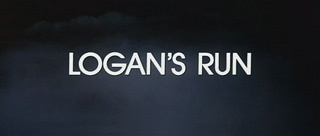
Logan’s Run began as a novel written in 1969 by William F. Nolan and George Clayton Johnson. It told a tale of a stressed Earth, where lives of sex, drugs, and personal pleasure had run wild, devouring the bulk of social and physical resources. To compensate for this lifestyle, society chose to enact a civic duty, in which no one was permitted to live past 21. At that point, they’d used their share of resources and had to sacrifice their life to prevent from using more than their share.

The novel followed the tale of Logan, a “Sandman”, part of the elite police force who was responsible for ensuring everyone performed their civic duty by reporting in time to a “sleep station”. When Logan turned 21, he rebelled against his own fate and fled, searching for a safe area in a world of cities beneath the sea, frozen artic prison colonies, great hollowed-out mountains, abandoned cities, through a terror-filled labyrinth, and ultimately to a spaceport where rockets took the successful “Runners” to safety on a rocket launched from Florida to a sanctuary station on Mars.
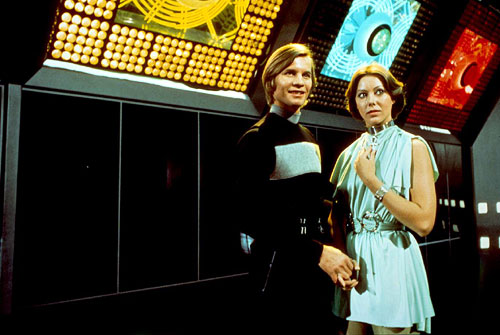
In 1976, MGM Studios released the film version of Logan’s Run starring Michael York as Logan 5, Richard Jordan as Francis 7, Jenny Agutter as Jessica, Farrah Fawcett-Majors as Holly 13, and Peter Ustinov as the Old Man. This major motion picture drastically altered the William F. Nolan story considerably, combining some critical elements of the novel and skipping others. The most dramatic alteration was changing the date of termination from 21 to 30. Rather than showing a world-wide technological society run by a central overlord computer, the film placed the world of the future in a city of domes, isolated from the decaying outside.
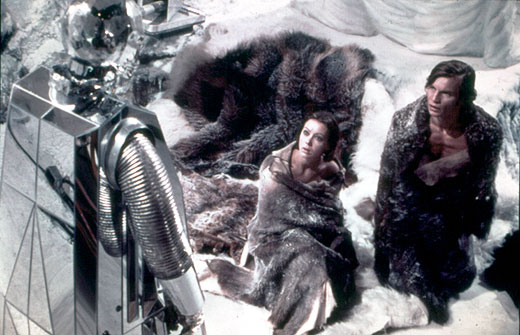
The movie deviated from the novel even further when it gained an R-rating, something MGM had hoped to avoid despite including some rather questionable material. Test audiences also through the film was too long. The studio executives ordered the film edited down to its present version. A second set of test audiences greatly preferred the shorter cut as did the raters who agreed to give the film a PG-rating. The longer cut version vanished mysteriously along with the original shorter version preview print.
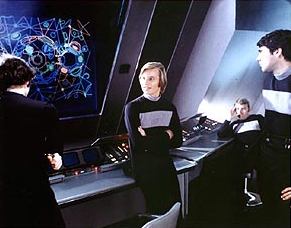
Among the things removed from the longer version are: an opening sequence where Francis killed a runner to the applause of nearby citizens, abundant references to the thrilling effects of taking various drugs, three minutes of sexual encounters in the Love Shop, Logan and Jessica posing for an ice sculpture before they learn of Box’s true nature, and a reading of the Old Man’s “cat poetry”.
Logan’s Run received the Oscar for Special Effects at the 1977 Oscar ceremony. The effects were quite elaborate, the most impressive being the huge miniature city model. Of special note was the backdrop of Sandman Headquarters (seen out the window of Logan’s apartment in the film). That backdrop was later used in several episodes of Star Trek – The Next Generation to represent Star Fleet Academy.

William F. Nolan continued the exploits of Logan in a sequel novel, “Logan’s World”, released in 1976. That novel showed more of the post-holocaust nature of the world Logan had helped create. In this novel, Logan searched for his kidnapped wife, Jessica, and battled the gang members responsible for her disappearance.
In 1977, based on the great success of the film and the avid search for anything science-fiction related due to the smashing success of the first Star Wars film, CBS rushed “Logan’s Run – The Television Series” into production. It retold the story from the film and incorporated some unused elements from the novel. The television series, set 200 years after a nuclear holocaust that destroyed most of Earth’s civilization, starred Gregory Harrison as Logan 5, Heather Menzies as Jessica, and David Moffat as the android REM.
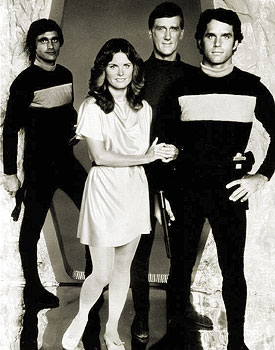
Like the motion picture, Logan and Jessica were ultimately driven by their goal of returning to the Domed City to liberate their friends left behind, although the series focused more on the other cultures they discovered on the way.
The third book, “Logan’s Search”, released in 1980, held little real connection to the first two and abruptly plunged Logan into an interdimensional conflict with other interdimensional travellers, all of whom resembled people from Logan’s past. This novel was poorly written, poorly executed, told an extremely weak story, and comes off as an insult to the extremely well written “Logan’s Run” and “Logan’s World”.
Despite the very poor effort in “Logan’s Search”, William F. Nolan continued the novelizations in 2000 by publishing all electronic versions of new Logan novels. He authored a combined three novel set, titled “Logan’s Return” for Virtual Publishing, who released the books in Adobe PDF format. In the fall of 2001, he suddenly ended his relationship with Virtual Publishing. “Logan’s Return” was out of print until the fall of 2001 when Mr. Nolan self published the work, signing each copy and adding a drawing of Logan on each cover for authenticity. William F. Nolan has also written four Logan short stories, currently unpublished.
George Clayton was developing a new book set between the first and second Logan’s Run novels. This tale, tentatively called Jessica’s Run, was told though the eyes of a unique character, and each chapter of the book was represented as a tarot card dealt by the books narrator. At last account, the book was abandoned after being 1/3 complete in the early 1980’s.
– written by the Two-Brained Cylon